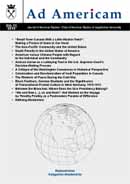Colonization and Decolonization of Inuit Population in Canada
Colonization and Decolonization of Inuit Population in Canada
Author(s): Magdalena Paluszkiewicz-MisiaczekSubject(s): Social Sciences
Published by: KSIĘGARNIA AKADEMICKA Sp. z o.o.
Summary/Abstract: The aim of the paper is to present specific way of colonization of the Canadian North with its typical outcomes and results, as well as contemporary attempts of “decolonization” aiming at healing the ills and mistakes of the past. The Inuit were the last of the aboriginal groups in Canada to face contacts with European newcomers. It was due to the fact that for a long time their land was considered uninviting, frozen and absolutely barren. Thus, the first contacts were infrequent and connected mainly with attempts of geographical exploration (Hearne, Mackenzie) and establishment of few trading posts (Fort Smith, Fort of Good Hope, Coppermine). Demand for whale oil and baleen in 1850s brought the first bigger wave of explorers to the north and facilitated contacts with the local people. Another big wave of northern expansion came with mineral resources boom, Klondike Gold Fever in 1896 and later search for oil, gas, platinum and uranium. Larger scope of contacts with white people had substantial impact on the life of Inuit population resulting in gradual change of lifestyle, exploitation, family breakdown, diseases and alcohol. The process of “decolonization” began in late 1970s and early 1980s with revival of native population issues, especially the problem of land ownership, share of Inuit population in the profits from resources exploitation, interest in ecology and environmental protection. Creation of Nunavut in 1999 became so far the most marking step in the attempt to satisfy political, geographical and social claims of the Inuit population.
Journal: Ad Americam. Journal of American Studies
- Issue Year: 2010
- Issue No: 11
- Page Range: 91-97
- Page Count: 7
- Language: English

